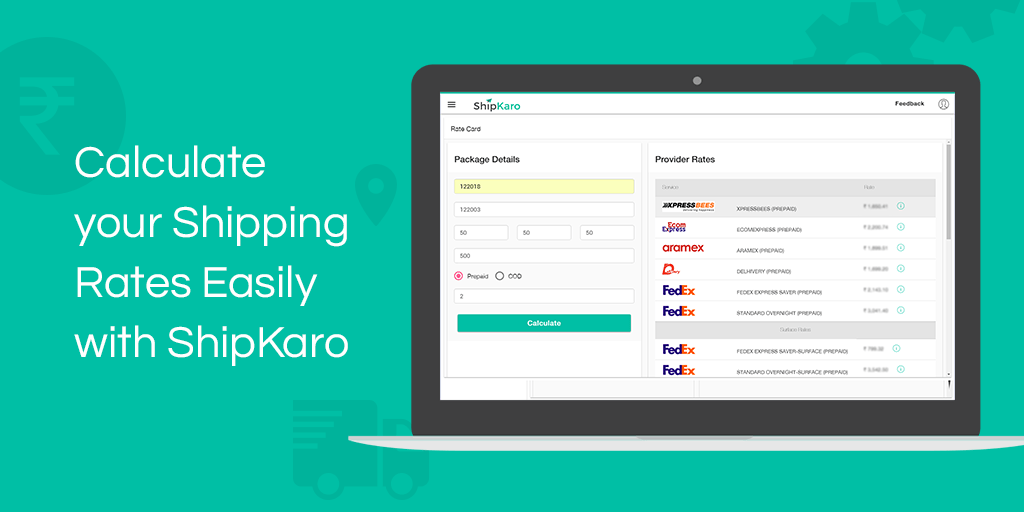As an ecommerce entrepreneur, you must be well aware of the crucial role that shipping plays in the entire product delivery life cycle. You must have also come across various logistics companies, each with their own terms and conditions ready to ship your products. One thing that stays in common for all the logistics companies is the Shipping Rate Calculator. You enter all the mandatory details related to your package and fetch the real-time rates instantly. Looks simple, isn’t it?
Ever wondered why does the ecommerce logistics companies ask for the specific details regarding your package?
In the process of rate calculation and shipping, you may come across several jargons involved in the rate calculation. Don’t you get puzzled with all the technical terms mentioned?
Being an ecommerce retailer, you should be aware of the entire process. It becomes important to be familiar with all the terms involved in the shipping process so that you can choose a suitable logistics provider for your business.
Let’s go through a complete overview of all the factors involved in the rate calculation process which will help you get a crystal clear image of how it works.
The package weight- The weight of the packed product is considered as the package weight. It is the first factor counted for calculating the shipment rates. Dead/Dry weight or volumetric weight whichever is higher is taken while calculating the rates. The volumetric weight is calculated as (length × width × height) / (dimensional factor). Dimensional factor may vary from 2700 to 5000 cm3/kg depending on the respective logistics partner. In case, declared weight differs and is less than actual weight, shipping charges get revised to actual weight.
The package size- The size of the packed product measured using the length, breadth, and height refers to package size. These dimensions of the package are used for the rate calculation of the shipment by the ecommerce logistics companies.
The location- The journey of the package from the warehouse to the delivery address should be defined. Thus, the source and destination location becomes necessary to determine the total distance to be covered by the package.
Base freight- For keeping the shipping process simplified, various shipping zones viz Zone A, B, C, D, and E are defined as per which the shipments are carried out. The base freight is determined for every zone by the shipment company. Hence, the base freight or the price at which the cargo is delivered from one location to another is considered as a part of the calculation.
Fuel surcharge- Shipping a package from one location to another requires fuel for transportation. Thus, to cover the fluctuating costs of fuel, the fuel surcharge is also factored in to cover the cost of operations.
COD Surcharge- Ever wondered why customers have to pay extra for COD orders sometimes? COD surcharge is applicable only for the COD orders. Various ecommerce shipping companies have their COD surcharge defined. Whereas, a fixed percentage of the entire order value is also considered as the COD surcharge. The fixed percentage value is calculated depending on the order value is compared with the listed COD surcharge defined by a particular shipping company. The greater amount amongst the both is the final COD surcharge to be applied.
Let's consider an example. The COD surcharge for FedEx is Rs 68 whereas the percentage COD surcharge applied is 2% for a shipping company that it is integrated with. For a shipment worth Rs 2500, the 2% COD surcharge is Rs 50. In this case, the COD Surcharge defined by FedEx will be considered as it is the greater one.
Government taxes- GST is the only government tax that is currently imposed all over India. The GST is added to the final calculation to obtain the final rates.
Now that you are aware of the factors involved in calculating the real-time shipping rates, you can choose a logistics provider confidently.
You are free to choose an individual logistics company or even pick a logistics platform provider that provides the benefit of integration with multiple courier companies. Choosing a logistics aggregator platform is a better choice as it offers integration with host of delivery partners and also offers more streamlined and automated services. You will also find it more economical as such platforms can negotiate discounted parcel rates from logistics companies based on their overall order volume.
ShipKaro is one such logistics aggregator platform that offers you a host of benefits.
Just enter the shipment details in the ShipKaro rate calculator and all the real-time rates by the shipping partners will be fetched automatically for you. The ShipKaro rate calculator relies on the live data from the shipping companies and thus the approximate rates are calculated in a jiffy. You are now free to compare the rates of all the listed shipping partners and pick the most convenient option among for shipping to the desired location.
If you think this is a one of the best feature provided by a logistics platform provider, then there is something more for you. ShipKaro aims at making the shipping part easy and time-saving for the e-commerce business owners. Thus, multiple features like bulk order shipment, automatic order synchronization, easy shipment tracking, integration with the best carrier and channel partners are also a part of the package.
Conclusion
Now that you are aware of how the shipping rates are calculated by the ecommerce shipping companies, you can start shipping confidently and grow your e-commerce business with the help of amazing features provided by ShipKaro. Just don’t forget to calculate the real-time rates with ShipKaro rate calculator before choosing a shipping partner.
Blog
About ShipKaro
ShipKaro® is a StoreHippo ( Hippo Innovations Pvt. Ltd.) initiative aimed at offering fast, low cost and simplified logistics solutions by providing shipping aggregator services to Ecommerce business owners.
Information

© copyright 2017 shipkaro.com. All Rights Reserved.



Leave a Comment